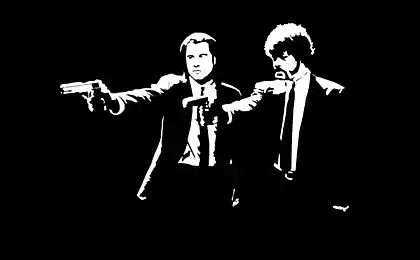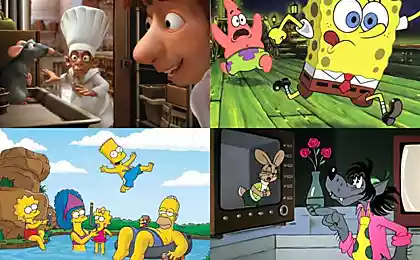1096
Interesting facts about wolves
Millennium people lived side by side with the wolves, though to this day, these predators are for human dangerous enemy. They are cunning, they have a stable hierarchical system, they are much smarter than their closest relatives - a dog.

Tail pipe
Wolves use facial expressions and movements in communication in the pack. Plays an important role tail. In the leader he raised high "pipe". This is the first sign by which to distinguish the leader. In the middle of the hierarchy, which usually consists of wolves older generation, it is omitted, and at the lower level in the wolf pack he is biased to the belly.
Central life revolves around the pack leaders that stand out not only physical endurance, as an individual. The leader always have to confirm its position. In addition to regular duties as a search of prey, path selection and protection of the pack, they are, in particular, often show aggression towards members of the pack: growl, bite, chase them. Especially aggression needed during mating. It suppresses the hormone levels in other members of the pack, making obey and killing competition. Under normal circumstances, the right of reproduction in the pack has only the alpha pair.
Smarter than dogs
Can be a long ode to sing about physical advantage over the wolf dog. But the wolf is not only stronger, but also smarter than their closest relatives, who have been tamed by man 15-18 thousand years ago. That is the conclusion drawn by researchers from the Research Institute Messerli at the Vienna Veterinary University. They conducted an experiment that involved 14 wolves and 15 mongrels, all about the same age, six months old.
Each was given an opportunity to once or twice to see how to train a dog, wielding his teeth and paws, opened the wooden box where he kept the food, and thus received a delicious trophy. Later, each of the puppies allowed to be next to the box where he kept the food. To the surprise of scientists, all the wolves repeated exactly what they've seen, and got to the food. But among the dogs, only four succeeded.
In the second phase of the experiment test complicated. Wolves provided to solve a similar problem but without prior demonstration, ie wolves faced boxes, without any clue how to open it. In this case, they showed not a brilliant result - a few have thought to bring down the lid legs or teeth. According to the authors, this proves that wolves are able to learn by watching the actions of other animals, imitating their behavior, if it provides them with benefits.
Numerous observations of the behavior of wolves show that they are more capable of imitation and care than a dog. Their brains are 30% larger than that of dogs. This additional memory, which uses a flock, including when traversing their territories and routes. They never move at random, and follow right through the herds of large ungulates, which often are their main diet. Their memory is a kind of directory that tells them, given them the familiar habits of the victim, where and with what probability they may meet one or another animal. Choosing the right direction to the place where it will be "served dinner," they rush him beaten path to intercept.
Black Wolf
In general, black wolves in nature should not be. Scientists from Stanford University in 2008 showed that the mutation responsible for the appearance of black wool, occurs only in dogs, therefore, black wolves - the result of interbreeding old gray wolves to domesticated dogs. It is still unclear what advantage is obtained specimens born in the black skin - that does not make them better hunters, but shows improvement in resistance to certain infections. Black wolves are most prevalent in North America.
Cannibalism
Despite the warm relations in the pack, wolves do not stop to eat their closest relatives, if fate has given such an opportunity. Of course, for the sake of food get into a fight no one will. Usually fatal clashes occur during mating between young players. Therefore, if a pack of someone badly injured or killed, his brothers and sisters will not give up such food. After all, nature is not bestowed these predators simple life. Sometimes it has to do without food for up to two weeks. Frequent victims during the war between flocks becomes the alpha pair - wolves, like humans, killed leaders, defeated the enemy.
Tame, pardon
People often incorrectly put a comma in this sentence, believing that miracles happen, and even a wild beast with good handling and use, can be tamed. Finally, the behavior of the cubs is no different from the usual puppies - they are always ready to play, enjoy fellowship, love their hozyaina.Razve that asking for more food. Yet wild animal remains wild, nature takes its toll. And it's not so much the amount of feeding, due to lack of a wolf which may lose control as the peculiarities of the social behavior of adult wolves.
There are many stories in which the wolf lived a long time in a person's home as ordinary dog, except that required more food, but everything changed with the onset of puberty. Adult wolf should take their place in the pack. Therefore matured beast always had to show that the "human pack" key - the owners of the house. And this should be done continuously, or "pet" just would occupy the vacant seat. In the end, the struggle for social hierarchy led to serious injuries or family members, or to Sleep beast. Domesticated wolf path in the woods ordered - it two ways, either the zoo or the veterinary table.

Tail pipe
Wolves use facial expressions and movements in communication in the pack. Plays an important role tail. In the leader he raised high "pipe". This is the first sign by which to distinguish the leader. In the middle of the hierarchy, which usually consists of wolves older generation, it is omitted, and at the lower level in the wolf pack he is biased to the belly.
Central life revolves around the pack leaders that stand out not only physical endurance, as an individual. The leader always have to confirm its position. In addition to regular duties as a search of prey, path selection and protection of the pack, they are, in particular, often show aggression towards members of the pack: growl, bite, chase them. Especially aggression needed during mating. It suppresses the hormone levels in other members of the pack, making obey and killing competition. Under normal circumstances, the right of reproduction in the pack has only the alpha pair.
Smarter than dogs
Can be a long ode to sing about physical advantage over the wolf dog. But the wolf is not only stronger, but also smarter than their closest relatives, who have been tamed by man 15-18 thousand years ago. That is the conclusion drawn by researchers from the Research Institute Messerli at the Vienna Veterinary University. They conducted an experiment that involved 14 wolves and 15 mongrels, all about the same age, six months old.
Each was given an opportunity to once or twice to see how to train a dog, wielding his teeth and paws, opened the wooden box where he kept the food, and thus received a delicious trophy. Later, each of the puppies allowed to be next to the box where he kept the food. To the surprise of scientists, all the wolves repeated exactly what they've seen, and got to the food. But among the dogs, only four succeeded.
In the second phase of the experiment test complicated. Wolves provided to solve a similar problem but without prior demonstration, ie wolves faced boxes, without any clue how to open it. In this case, they showed not a brilliant result - a few have thought to bring down the lid legs or teeth. According to the authors, this proves that wolves are able to learn by watching the actions of other animals, imitating their behavior, if it provides them with benefits.
Numerous observations of the behavior of wolves show that they are more capable of imitation and care than a dog. Their brains are 30% larger than that of dogs. This additional memory, which uses a flock, including when traversing their territories and routes. They never move at random, and follow right through the herds of large ungulates, which often are their main diet. Their memory is a kind of directory that tells them, given them the familiar habits of the victim, where and with what probability they may meet one or another animal. Choosing the right direction to the place where it will be "served dinner," they rush him beaten path to intercept.
Black Wolf
In general, black wolves in nature should not be. Scientists from Stanford University in 2008 showed that the mutation responsible for the appearance of black wool, occurs only in dogs, therefore, black wolves - the result of interbreeding old gray wolves to domesticated dogs. It is still unclear what advantage is obtained specimens born in the black skin - that does not make them better hunters, but shows improvement in resistance to certain infections. Black wolves are most prevalent in North America.
Cannibalism
Despite the warm relations in the pack, wolves do not stop to eat their closest relatives, if fate has given such an opportunity. Of course, for the sake of food get into a fight no one will. Usually fatal clashes occur during mating between young players. Therefore, if a pack of someone badly injured or killed, his brothers and sisters will not give up such food. After all, nature is not bestowed these predators simple life. Sometimes it has to do without food for up to two weeks. Frequent victims during the war between flocks becomes the alpha pair - wolves, like humans, killed leaders, defeated the enemy.
Tame, pardon
People often incorrectly put a comma in this sentence, believing that miracles happen, and even a wild beast with good handling and use, can be tamed. Finally, the behavior of the cubs is no different from the usual puppies - they are always ready to play, enjoy fellowship, love their hozyaina.Razve that asking for more food. Yet wild animal remains wild, nature takes its toll. And it's not so much the amount of feeding, due to lack of a wolf which may lose control as the peculiarities of the social behavior of adult wolves.
There are many stories in which the wolf lived a long time in a person's home as ordinary dog, except that required more food, but everything changed with the onset of puberty. Adult wolf should take their place in the pack. Therefore matured beast always had to show that the "human pack" key - the owners of the house. And this should be done continuously, or "pet" just would occupy the vacant seat. In the end, the struggle for social hierarchy led to serious injuries or family members, or to Sleep beast. Domesticated wolf path in the woods ordered - it two ways, either the zoo or the veterinary table.























